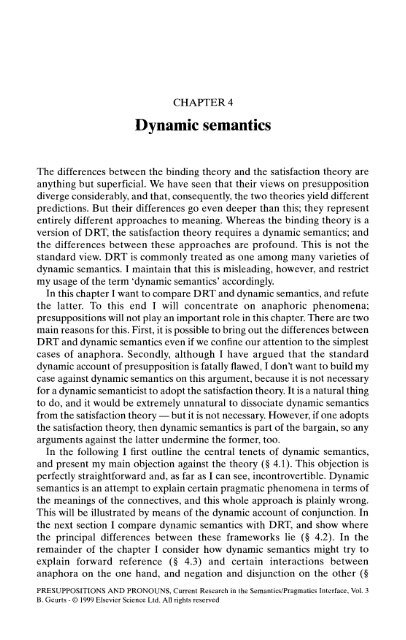Presuppositions and Pronouns - Nijmegen Centre for Semantics
Presuppositions and Pronouns - Nijmegen Centre for Semantics
Presuppositions and Pronouns - Nijmegen Centre for Semantics
You also want an ePaper? Increase the reach of your titles
YUMPU automatically turns print PDFs into web optimized ePapers that Google loves.
CHAPTER 4<br />
Dynamic semantics<br />
The differences between the binding theory <strong>and</strong> the satisfaction theory are<br />
anything but superficial. We have seen that their views on presupposition<br />
diverge considerably, <strong>and</strong> that, consequently, the two theories yield different<br />
predictions. But their differences go even deeper than this; they represent<br />
entirely different approaches to meaning. Whereas the binding theory is a<br />
version of DRT, the satisfaction theory requires a dynamic semantics; <strong>and</strong><br />
the differences between these approaches are profound. This is not the<br />
st<strong>and</strong>ard view. DRT is commonly treated as one among many varieties of<br />
dynamic semantics. I maintain that this is misleading, however, <strong>and</strong> restrict<br />
my usage of the term 'dynamic semantics' accordingly.<br />
In this chapter I want to compare DRT <strong>and</strong> dynamic semantics, <strong>and</strong> refute<br />
the latter. To this end I will concentrate on anaphoric phenomena;<br />
presuppositions will not play an important role in this chapter. There are two<br />
main reasons <strong>for</strong> this. First, it is possible to bring out the differences between<br />
DRT <strong>and</strong> dynamic semantics even if we confine our attention to the simplest<br />
cases of anaphora. Secondly, although I have argued that the st<strong>and</strong>ard<br />
dynamic account of presupposition is fatally flawed, I don't want to build my<br />
case against dynamic semantics on this argument, because it is not necessary<br />
<strong>for</strong> a dynamic semanticist to adopt the satisfaction theory. It is a natural thing<br />
to do, <strong>and</strong> it would be extremely unnatural to dissociate dynamic semantics<br />
from the satisfaction theory -— but it is not necessary. However, if one adopts<br />
the satisfaction theory, then dynamic semantics is part of the bargain, so any<br />
arguments against the latter undermine the <strong>for</strong>mer, too.<br />
In the following I first outline the central tenets of dynamic semantics,<br />
<strong>and</strong> present my main objection against the theory (§ 4.1). This objection is<br />
perfectly straight<strong>for</strong>ward <strong>and</strong>, as far as I can see, incontrovertible. Dynamic<br />
semantics is an attempt to explain certain pragmatic phenomena in terms of<br />
the meanings of the connectives, <strong>and</strong> this whole approach is plainly wrong.<br />
This will be illustrated by means of the dynamic account of conjunction. In<br />
the next section I compare dynamic semantics with DRT, <strong>and</strong> show where<br />
the principal differences between these frameworks lie (§ 4.2). In the<br />
remainder of the chapter I consider how dynamic semantics might try to<br />
explain <strong>for</strong>ward reference (§ 4.3) <strong>and</strong> certain interactions between<br />
anaphora on the one h<strong>and</strong>, <strong>and</strong> negation <strong>and</strong> disjunction on the other (§<br />
PRESUPPOSITIONS AND PRONOUNS, Current Research in the <strong>Semantics</strong>/Pragmatics Interface, Vol. 3<br />
B. Geurts - © 1999 Elsevier Science Ltd. All rights reserved














